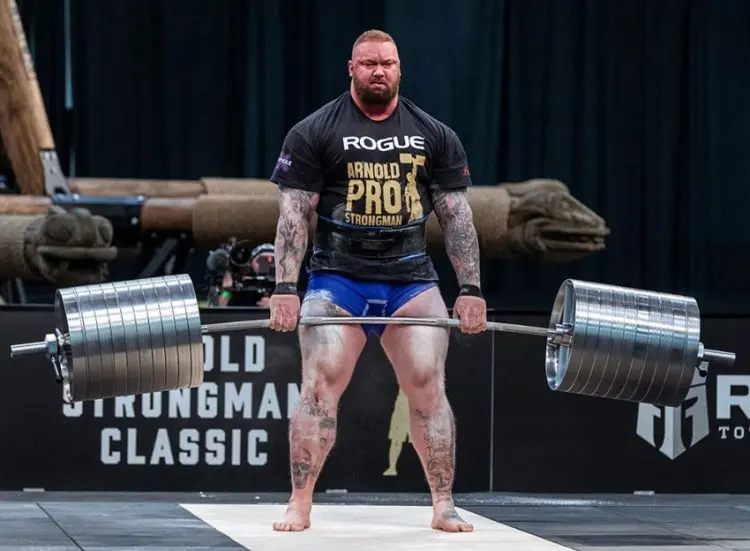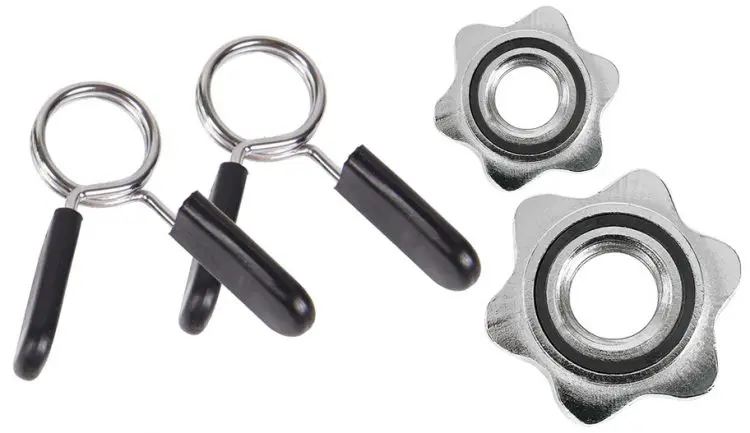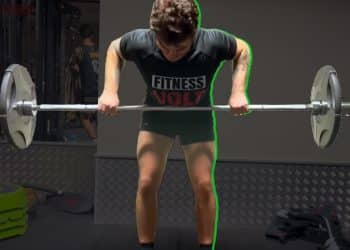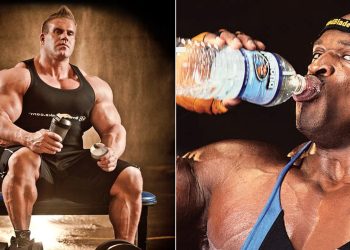Utilizing the barbell as a training tool is simply non-negotiable if you want to maximize your strength and development… just ask any powerlifter, weightlifter, or even a bodybuilder. But you see, there are many different barbell weights and types of barbells that are used for specific purposes (we’ll delve deeper momentarily).
And it’s nice to know this information (and we don’t mean just for the heck of it) because whether you’re an athlete, typical gym rat, or prefer to train at home, you have to use the right tool for the job.
Alright, let’s get down to business…
What’s a Barbell?
The barbell is the long one… you’ve probably heard this when you first got into training and was still learning the difference between the barbell and the dumbbell (well, it can be confusing).
So to reiterate, yes, the barbell is the long bar and the dumbbell is the compact, handheld weights. And actually, the barbell is the longer version of the dumbbell according to the history of weights.
Anyhow, barbells come in all shapes, sizes, and weights ranging from 4 foot (1.2m) to 8 foot (2.4m) long, and typically weigh anywhere from 1-70 or more pounds (0.45-31+ kg). Although anything longer than 7 feet (2.1m) is typically used by powerlifters for certain lifts (we’ve also included those bars).
Level Up Your Fitness: Join our 💪 strong community in Fitness Volt Newsletter. Get daily inspiration, expert-backed workouts, nutrition tips, the latest in strength sports, and the support you need to reach your goals. Subscribe for free!
Barbells are loaded by sliding the weight plates on the ‘sleeves’ at either end and they’re secured with collars or clamps (some opt to not secure the plates with these devices). The bars also have a variety of knurling patterns for secure gripping and slip prevention and the bar thickness or diameter varies.
The barbell is used for squats, deadlifts, bench presses, bent-over rows, and many other exercises.
Exercisers or competitive lifters are able to lift the heaviest possible poundages (in free weight form) when using a barbell because it’s considered bilateral (affecting both sides). This means that you’re gripping the bar with both hands, and this requires less stabilization, balance, and coordination.
Although, training with a barbell still requires all three components of performance as it’s considered a free weight movement and you’re not locked into any apparatus.
But with dumbbell training which is unilateral by nature, you have to focus and stabilize a bit more because each side is working independently.
The barbell also has downsides as it’s more restrictive of natural movement, plus you need a spotter during maximal lifts and equipment (e.g., bench press station, squat rack) for exercises such as the squat, bench press, shoulder press, etc.
Not to mention, if you train at home, you’ll need a barbell suitable for your space and/or goals.
Here’s our list of barbell weights…
Different Barbell Weights/Variations
Here’s a list of the different barbells and basic information on each one.
Men’s Olympic Barbell
The men’s Olympic barbell is common in gyms. It’s 7.2 ft long and weighs 20kg/44 lbs with 2-inch diameter weight sleeves.
It can support very heavy weights up to 1,200+ lbs (544+ kg).
What differentiates the Olympic bar from others is that it has bearings/bushings that cause the sleeves to rotate. This is ideal for Olympic lifts (snatches and clean and jerks) because it reduces the torque caused by the weight plates and allows for smoother movements, especially from the floor to overhead. It also helps to improve grip and reduces stress on the wrists and elbows.
These bars are also made from special steel and construction that allows them to have a decent amount of whip or flexibility where the bar bends and slack is taken out of the bar before the weight is pulled off the ground.
This is useful for using momentum to propel the bar upward and is ideal for weightlifting and CrossFit activities. Although most people won’t have the skill to use the momentum of the whip to their advantage. But the men’s Olympic bar can be used for any lifts although it’s not the best option for every lift.
Olympic bars are also designed to be dropped from overhead and avoid damage or bending.
Power Bar
The power bar is similar to but stiffer than the Olympic bar, which is ideal for the squat, bench press, and deadlift (although whip can be good for very heavy deadlifts). It’s the most commonly used in gyms for compound lifts.

The power bar typically weighs the same as the Olympic bar at 44-45 pounds. It also doesn’t rotate like the Olympic bar and this is better for basic heavy lifts.
Standard Barbell
Standard bars can be as long and weigh as much as the men’s Olympic bar and some even refer to the Olympic bar as the standard bar. But standard bars aren’t standardized for competition, unlike Olympic bars.
If we’re talking about what many call a ‘standard,’ and not an Olympic barbell, it has a few differences such as non-rotating sleeves, one-inch diameter sleeves, less aggressive knurling, different steel material, etc. These are among the most commonly used bars in gyms, suitable for bench press, squats, deadlifts, and anything else.
They can vary in length, ranging from 5-7.1 feet while weighing 15-44 pounds (6.8-20kg).
This standard bar is also not made to hold as much weight as the Olympic or power bar.
You can’t use standard bar plates for an Olympic bar, however, you can use Olympic bar plates on standard bars with the use of an adapter sleeve that you slide on.
Women’s Olympic Barbell
For women who may not be able to train with the men’s Olympic or power bar, a shorter, thinner, and lighter bar is obviously ideal.
The average women’s barbell is about 2.01 meters (79.2 inches) in length and weighs 15kg/33 lbs. It also has spinning sleeves for the reasons mentioned.
The thinness of the bar is also better for most women when using the hook grip (wrapping the fingers over the thumb for more security and proper muscle engagement).
Smith Machine Bar
The weight of a Smith machine bar varies depending on the design of the machine. Some use a counterweight to make the bar lighter while others don’t.
The counterweight can cause the bar to weigh just 15 pounds. In contrast, ones that don’t use a counterweight may weigh up to 40 lbs.
It can be hard to guesstimate a Smith machine bar’s weight especially because it moves along a straight path between guide rods. You can also ask the gym staff to find out for you or see if the manufacturer can give you that info.
Level Up Your Fitness: Join our 💪 strong community in Fitness Volt Newsletter. Get daily inspiration, expert-backed workouts, nutrition tips, the latest in strength sports, and the support you need to reach your goals. Subscribe for free!
EZ Bar

The EZ bar or EZ curl bar is much shorter than the Olympic bar and has curves that allow for different wrist/grip angles. As a result, people use this bar for certain exercises such as biceps curls, triceps extensions/exercises, and upright rows because it reduces strain on the wrist.
EZ bars typically weigh 15-25 pounds (6-11kg) although it can vary.
Fixed Barbell
A fixed barbell is a bar with the weight fixed or attached to a shorter bar. The weight is displayed at each end, usually on the outer sides of the weights.
Squat Bar
Many use the Men’s Olympic, power, or standard bar for squats. But what people are referring to when they say “squat bar,” is the Texas power bar. It has center knurling to prevent the bar from slipping down the back. They’re also typically thicker and have very little whip.
The squat bar typically weighs 20kg/44lbs.
Then you have the cambered squat bar where two L-shaped bars are attached underneath on either side so that the plates can load lower than the part that sits across the upper back. This allows you to grip the bar low and wide which can significantly reduce shoulder stress and makes free weight squatting more possible for this with shoulder or arm injuries.
It can be odd squatting with this bar though but it has its utility for some people. This cambered squat bar weighs about 29kg/65 pounds.
Safety Squat or Yoke Bar
A safety squat bar has two parallel handles or ‘arms’ with a neck cushion that you can hold onto during squats. These bars typically weigh 60-70 lbs (27-31kg).
The yoke changes things a little compared to the conventional barbell back squat. Not only is it more desirable for relieving or preventing shoulder stress, but it causes you to lean more forward. This engages more of the posterior chain muscles like the glutes, hamstrings, and spinal erectors.
It’s a really nice tool to have at your disposal.
Deadlift Bar
Earlier this year, Strongman icon Hafthor Bjornsson broke the all-time deadlift world record by pulling 501kg/1105 lbs using the deadlift bar.

The deadlift is the ultimate test of brute strength. Therefore, deadlift-specific bars need to allow for the heaviest of weights to be pulled off the ground. Deadlift bars are similar to the power bar in length and weight but whippier and thinner which offers an advantage and allows for advanced technique to lift maximum weight off the floor.
Certain deadlift bars can be longer like the Rogue deadlift bar that is 7.5 feet long and also has extended sleeves for more whip. The knurling also has to be more aggressive to maintain optimal grip for moving huge poundages!
Most deadlift bars weigh 20kg/44 lbs.
Youth Weightlifting Bar
The youth weightlifting bar is typically utilized as a training tool for beginners and during youth activities. It can be as long as 1.7 meters (60-67 inches) and weigh 5kg-10kg (11-22 lbs).
Multi-grip or Swiss Bar
This bar looks like a ladder (in its most basic form) and goes by many names such as the Swiss bar, multi-grip bar, and football bar.
There are different variations of the Swiss bar, some with neutral-only or angled-only grips and some that have neutral and angled handles. There are also different sizes and weights. Also, some are made with fixed sleeves while others rotate.
You can set it up as you would the barbell bench press to work your chest but it has tons of potential uses and advantages over the straight bar. You can press it in any direction, row it, curl it, use it for push-ups, and much more.
Not to mention, if you have shoulder issues, it’s an ideal tool to have in your arsenal, although not totally necessary. You also won’t be able to press as much weight overall compared to the straight bar press due to design.
But it’s versatility makes it an overall unique and beneficial piece of training equipment.
Most Swiss bars weigh 35-45 lbs (15-20kg), although it varies like many of the other bars on this list.
Tricep Bar
The tricep bar is excellent for triceps extensions, close-grip presses, hammer curls, and anything else suitable. These bars are often about 34 inches in length and weigh anywhere from 9-18kg/20-40 pounds.
Trap Bar
The trap bar is a trapezoid or hexagon-shaped (also called hex bar) implement that allows you to stand in the center and grip the handles located on either side. This is better for keeping the weight closer to your center of gravity which can alleviate the stress on the spine and back.
It was originally designed for shoulder or trap shrugs but there are many other exercises that you can do as well such as farmer’s walks, deadlifts/variations, and more.
These bars typically range in weight from 36 to 65 lbs.
Weighted Bar
No, we didn’t think up another name for a barbell and call it a weighted (I thought you knew us better than that). It’s actually a thing FYI and many use it for lighter workouts and cardio-type training. These bars can be 4 and 5 feet long and can range in weight from 1 to 30 pounds or more.
They display the weight on the side too.
What About The Clips or Clamps?
Most people don’t factor in the weight of the clips, clamps, or collars that secure the plates or prevent them from moving or sliding off. They don’t add a lot of weight but make no mistake, it can certainly make a small difference.
The standard spring clips that you squeeze and slide onto the bar weigh about a quarter of a pound, while the heavier clamps or collars can weigh up to two pounds.
That means you can add a half to four pounds to your lifts with these securing devices alone. If using the lightest clips or clamps it’s probably not worth including in total weight lifted. But for the heavier ones… why not!
Wrapping Up
We truly hope you found this list of barbell weights helpful whether you were just curious, or whether it’ll come in handy as you progress in your training efforts.
Many people guess how much the bar weighs but that won’t quite cut it (unless you simply don’t care which is fine), especially if you’re training for competition, tracking your progress, or want to brag to your friends about your iron-slinging abilities.
But it’s also important to mention that sometimes bar weights can vary even if they are the same, and you may have to get a measurement yourself.
Now you know how much the bar weighs…
















